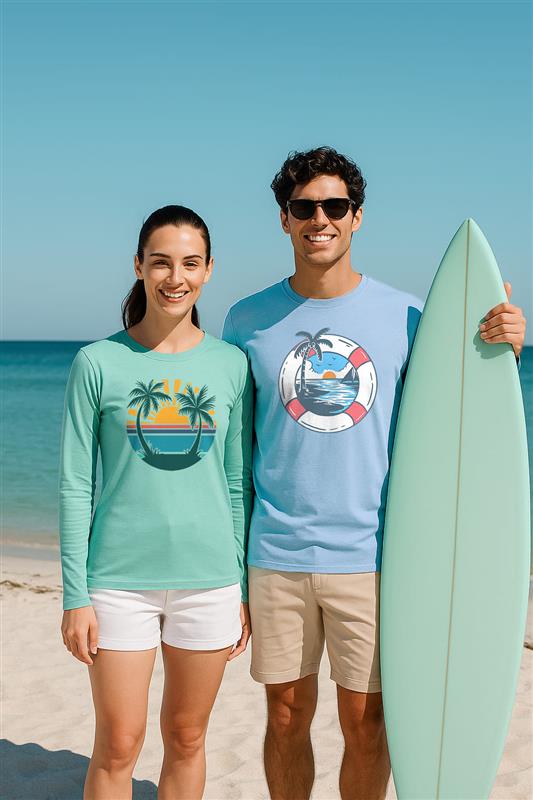The Best Clothing Fabric For Outdoor Adventures: Cotton Vs Moisture-Wicking

What you wear for a hike contributes significantly to how safe and comfortable you are. Choosing moisture-wicking materials versus regular cotton is one such main decision. It influences how dry, cool, and covered you remain during the hike. Material selection is important. Moisture-wicking apparel helps pull sweat away from our bodies, while cotton holds water.
Most think cotton is good for all, but hiking has special demands. The proper fabric will keep us from being cold, sweaty, or even developing blisters from wet clothing. Knowing how each fabric performs enables us to pack more efficiently and have fun on the trail.
Key Takeaways
-
Fabric choice influences performance and comfort while hiking.
-
Moisture-wicking clothing dries us out, while cotton holds sweat.
-
Knowledge of the benefits allows us to make better decisions for any hike.
How Your Clothes Affect Comfort In The Outdoors
A comfortable hiking experience can be enhanced with the right clothing. Fabric choice affects our feelings, especially during long walks or changing weather. We want to avoid clothes that trap sweat or get heavy when wet.
Moisture-wicking vs cotton hiking clothes can make all the difference in this. Breathability is key. When you wear non wicking clothes, you feel uncomfortable and sticky.
Clothing that wicks away sweat leaves our skin dry and chafe-free. Cotton holds sweat but does not dry quite so quickly and leaves us chilly if the weather becomes inclement.
Having on the right material also protects us from skin irritation. We walk more when hiking and sweat more. Our material has to work for us, not against us. Choosing the right one lets us enjoy the trail, not our clothes.
What Are Fabrics That Wick Away Moisture?
Moisture-wicking clothing draws sweat away from your skin, keeping you dry. They push the moisture outside, where it rapidly evaporates. Hiking becomes more comfortable when you do this, especially when you are working up a sweat.
Most hiking clothing that wicks moisture is synthetic. Plus, nylon and polyester are the most popular fabrics used in hiking shirts, pants, and socks. Clothes that wick moisture dry faster and hold less moisture than cotton.
Sometimes, companies use blends. These blends could combine polyester or nylon with a little bit of spandex for stretch. The aim is frequently to make a fabric that dries quickly but remains comfortable.
Key Features of Moisture-Wicking Fabrics
|
Fabric Type |
Wicking Ability |
Common Use |
|
Polyester |
High |
Shirts, Base Layers |
|
Nylon |
High |
Pants, Shorts |
|
Synthetics Blend |
Medium/High |
Socks, T-shirts |
The Performance Of Fabrics In Outdoor Environments
Hiking clothes need to handle heat, sweat, and odor. What you wear can affect your comfort and health. When we compare moisture-wicking vs cotton hiking clothes, moisture-wicking fabrics dry fast and keep you cool. Cotton holds sweat and stays wet. Knowing the pros and cons of each helps you choose better. The right fabric makes hiking safer and more comfortable.
Control of Temperature
Moisture-wicking fabrics like polyester and merino wool help us stay cool in summer and warm in winter. They pull sweat off our skin and let it dry fast, which keeps our body temperature steady and prevents that sticky, clammy feeling.
Cotton works differently. It soaks up sweat and holds onto it. Cotton simply sticks to your skin and doesn't do anything to assist you cool down, even in the presence of a cool wind or shade. This might be risky in cold weather since wet cotton dissipates body heat.
|
Feature |
Moisture-Wicking |
Cotton |
|
Heat Management |
Removes sweat quickly |
Holds moisture |
|
Cold Protection |
Keeps warmth |
Loses heat easily |
|
Comfort When Wet |
Stays light |
Becomes heavy |
The Importance Of Fast-Drying Clothing
When hiking in rainy or muggy conditions, quick-drying clothing is crucial. They lessen the chance of rashes, blisters, and chafing while also keeping you dry and avoiding pain.
Compared to cotton, moisture-wicking textiles dry considerably more quickly. You save time waiting for damp clothes to dry and stay comfortable doing this.
Conversely, cotton dries slowly and absorbs water. It can get saturated for hours with just a little perspiration or rain. Your hike may become more difficult and less pleasurable as a result.
The speed at which our equipment will dry must be taken into account while choosing what to wear. We can stay dry, comfortable, and safe on the trail by wearing clothing that wicks away moisture.
How Fabrics Control Sweat And Smells
Odor control matters when we hike for hours or days. Synthetic materials often trap smells from sweat, even after one day of hiking. This can make our clothes feel dirty faster.
Many moisture-wicking clothes use special treatments or fibers like merino wool to limit odor. Merino wool is naturally less smelly because it stops bacteria from growing. Polyester and nylon can get smelly, but some items use anti-odor technology.
Cotton does not manage odor well. Wet cotton holds sweat and grows bacteria more easily over time, which causes strong smells. If we plan to hike for several days, odor-resistant fabrics can make a big difference.
Benefits of Moisture-Wicking Hiking Clothes
Hiking clothing that wicks away moisture keeps us comfortable, dry, and weather-ready. During longer hikes, they protect our skin, last longer, and make layering easier.
Comfort And Skin Health
Wearing wicking clothing lets us avoid the tacky, wet feeling that comes with cotton. These clothes pull sweat off our skin and dry rapidly, keeping us cool and cleaner.
Trapping the moisture results in chafing, skin irritation, or even rashes while we hike. Because moisture-wicking clothing dries us, they lower the risk of such skin issues. They don't trap sweat against our skin, unlike cotton.
Most moisture-wicking fabrics, such as polyester or merino wool, are stretchy and soft. They are comfortable to wear all day, even in rain or heat. We can concentrate on the trail, not our clothes.
Durability And Longevity
Moisture-wicking hiking clothes are designed for rough use. They usually resist tearing and hold their shape after many washes. Cotton, on the other hand, breaks down faster, especially after getting wet and drying again and again.
These technical fabrics do not stretch out or fade as much with time. They are also less likely to shrink in the wash. Investing in these clothes will save you money over time since they won't need replacing as often.
We can trust our gear to keep up with us on long hikes. Their strength makes them better choices for back-to-back hiking days or backpacking trips.
Layering Capabilities
Moisture-wicking clothing makes an excellent base layer. It's fitted close to our skin and doesn't add bulk, making it simple to add extra layers over the top, such as a fleece or rain jacket, without the added burden.
Since these materials move sweat away efficiently, the top layers also remain dry. As a result, we don't get chilled during the winter since moisture isn't retained under our coats.
With clothes that layer easily, we can modify our wardrobe as the weather dictates. This helps us to stay safe and comfortable on the trail, whether the day is hot, cold, or in between.
Benefits Of Cotton Hiking Clothes
Cotton hiking clothes have long been a popular choice. They offer clear advantages in price, comfort, and daily usability but also have important downsides.
Affordability And Accessibility
Cotton clothes are usually more affordable than moisture-wicking ones. T-shirts, pants, and socks made of cotton are readily available in most stores. They're widely available and budget-friendly. No need to look in specialty stores or pay more for name brands.
Cotton hiking apparel is a simple introduction for new hikers or budget-conscious hikers. Additionally, prices are usually lower, and sales or multipacks are common.
|
Feature |
Cotton Clothes |
Moisture-Wicking Clothes |
|
Price |
Usually lower |
Usually higher |
|
Store Availability |
Very common |
Sometimes limited |
|
Brand Variety |
Wide selection |
Fewer choices |
|
Requires Special Care |
Rarely |
Sometimes |
Softness And Comfort
Cotton is also famous for being soft on our skin. When you have been hiking for hours, this really matters. We don't have to deal with stiff material or scratchy seams.
Most individuals find the cotton sensation preferable, particularly on hot sunny days. Natural fibers allow air to pass through, minimizing itch or discomfort potential. Cotton tops tend to remain comfortable even after a long stroll.
The soft material is also good for people with sensitive skin. We can wear cotton for hours with little irritation. While cotton may not stretch much, its natural softness might keep us comfortable on easy and moderate trails.
Everyday Versatility
Cotton hiking clothes can be worn almost anywhere. We can go straight from the trail to the store or have a casual lunch without changing. This makes it easy if we plan more than just hiking on our day out.
Cotton items do not stand out as “specialty” gear. Simple cotton pants or shirts blend in well with our regular clothes. This can save our money since we aren’t buying gear for just one purpose.
Cotton is a good choice for clothes that work for hiking, school, or errands. Because cotton is suitable for both hiking and daily use, we could pack fewer clothes for a trip.
Why Cotton Isn’t Ideal For Long Hikes
-
Despite the benefits, cotton has important downsides for hiking. The main problem is that cotton holds onto water. When we sweat or get caught in the rain, cotton gets wet and takes a long time to dry. It can cause chafing and make us feel cold when cotton is wet.
-
Wearing wet cotton increases the risk of blisters or skin problems on long hikes. It can even be dangerous in cool weather because it pulls heat away from our bodies. This is why some people say "cotton kills" for cold or wet hikes.
-
Cotton should not be chosen for longer trips or rough weather hikes. If we wear cotton outdoors, it's smart to be prepared with an extra shirt or a backup layer.
Comparing Moisture-Wicking Fabrics To Cotton
-
When we choose hiking clothes, we need to compare moisture-wicking fabrics with cotton. Each has clear pros and cons for the trail.
-
Moisture-wicking clothes pull sweat off your skin, helping you stay dry and warm during a hike. They also dry quickly, which is really helpful if you get wet or sweaty.
-
Cotton does the opposite—it soaks up moisture and holds it close to your body. Once it’s wet, it feels cold and heavy. That’s not ideal for long walks or rainy conditions.
-
Moisture-wicking gear may cost more, but it offers better comfort and dryness. Cotton is cheaper but doesn’t perform well in sweaty or damp situations.
-
Think about your hiking plans, the weather, and how long you’ll be out. For most hikes, moisture-wicking clothes are the smarter, safer choice.
|
Feature |
Moisture-Wicking Fabric |
Cotton Fabric |
|
Moisture Control |
Pulls sweat away from the skin, dries quickly |
Absorbs and holds moisture, stays wet longer |
|
Comfort During Activity |
Feels dry, light, and breathable during movement |
Soft and breathable, but uncomfortable when damp |
|
Weight & Drying Time |
Lightweight and fast-drying, even on the trail |
Gets heavy when wet, takes much longer to dry |
|
Warmth When Wet |
Retains warmth due to quick-dry properties |
Loses insulation and feels cold when soaked |
|
Odor Control |
Merino wool resists odor; synthetics may retain some smell |
Can trap sweat and odor over time |
|
Cost & Accessibility |
Generally more expensive but performance-focused |
More affordable and easy to find |
Frequently Asked Questions
What Benefits Do Moisture-Wicking Cloth Offer Over Cotton?
Sweat is drawn away from your skin by moisture-wicking clothes. This keepes you comfortable and dry. They lessen the chance of chafing and dry rapidly. They are therefore a better option for hiking than cotton.
Keeping warm in the winter and cool in the summer is made possible by these materials.
Why Is Cotton Not A Good Option For Hiking?
Cotton is slow to dry and will absorb water. When wet, it clings to your skin and makes you cold. You might even become more prone to hypothermia in cold temperatures.
Can Moisture-Wicking Clothes Also Be Waterproof?
Yes, certain apparel possesses both qualities. The sweat-wicking inner layer is complemented by a rain-blocking outer shell. This makes you dry on the inside and out.


